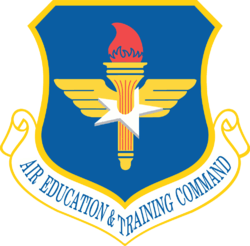562d Flying Training Squadron
| 562d Flying Training Squadron | |
|---|---|
 Boeing T-43 operated by the 562d at RAF Fairford | |
| Active | 1942-1945; 1947-1949; 1953-1957 1962-1972; 1974-1992; 1993-2010 |
| Country |
|
| Branch |
|
| Role | Navigator Training |
| Part of | Air Education and Training Command |
| Garrison/HQ | Randolph Air Force Base |
| Engagements |
European Theater of Operations Vietnam War[1] |
| Decorations |
Distinguished Unit Citation Air Force Outstanding Unit Award with Combat "V" Device<br/Air Force Outstanding Unit Award[1] |
| Insignia | |
| 562d Flying Training Squadron emblem (approved 28 July 1970)[1] |
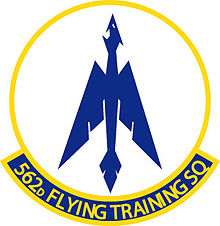 |
| 562d Bombardment Squadron emblem (approved 7 July 1944)[2] |
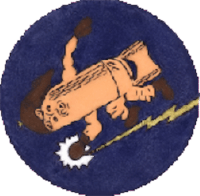 |
The 562d Flying Training Squadron was part of the 12th Flying Training Wing based at Randolph Air Force Base, Texas. It operated the Boeing T-43 Bobcat conducting navigator training
History
World War II
The 562d was first activated as the 562d Bombardment Squadron on 24 December 1942 at Gowen Field, Idaho, on 24 December 1942, and moved to Wendover Field, Utah on 5 February 1943, where it began training in Boeing B-17 Flying Fortress aircraft. The squadron participated in approximately 300 combat missions in the European Theater of Operations from 17 July 1943 until its last World War II mission, flown to the Landsberg Aerodrome near Munich, on 21 April 1945. During the summer of 1945, the 562d airlifted food to starving people of the Netherlands.[3]
Air reserve
The squadron was activated in the reserves at Orchard Place Airport, Illinois on 12 June 1947 and assigned to the 338th Bombardment Group. The squadron trained under the supervision of Air Defense Command (ADC)'s 141st AAF Base Unit (Reserve Training) (later the 2471st Air Force Reserve Flying Training Center), although it does not appear that it was fully manned or equipped.[1][4] Although nominally a bombardment unit, the squadron was equipped with North American AT-6 Texan and Beechcraft AT-11 Kansan trainers.[1]
In July 1948 Continental Air Command (ConAC) assumed responsibility for managing reserve and Air National Guard units from ADC.[5] In 1949, the 562d began to fly a few Curtiss C-46 Commando and Douglas C-47 Skytrain troop carriers and Douglas B-26 Invader light bombers, but it was inactivated in June when ConAC reorganized its reserve units under the wing base organization system. President Truman’s reduced 1949 defense budget also required reductions in the number of units in the Air Force,[6] At O'Hare, the 338th Group and its squadrons were inactivated, and most of its personnel transferred to the 437th Troop Carrier Wing.[4][7]
Fighter operations
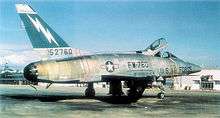
From 1953 until 1980, the squadron saw several periods of activation and inactivation. During this period, the 562d flew North American F-86 Sabre, North American F-100 Super Sabre, and Republic F-105 Thunderchief aircraft at various bases. During 1965, while stationed at McConnell Air Force Base, Kansas, the 562d deployed to Takhli Royal Thai Air Force Base, Thailand, where it participated in five months of sustained combat operations in the Vietnam War.[3]
Wild Weasel operations
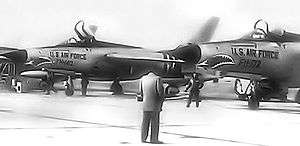
From 31 October 1974 to 30 June 1992, the 562d was stationed at George Air Force Base, California to fly the F-105 and then the McDonnell F-4G Phantom II aircraft conducting Wild Weasel missions. During this time the squadron also participated in Operation Desert Storm.[3]
Navigator training
The 562d Flying Training Squadron conducted part of the Specialized Undergraduate Navigator Training at Randolph Air Force Base, Texas as part of the 12th Flying Training Wing until navigator training and Electronic Warfare Training was combined into the Combat Systems Officer (CSO) Training and moved to Naval Air Station Pensacola.[3]
Lineage
- Constituted as the 562 Bombardment Squadron (Heavy) on 19 December 1942
- Activated on 24 December 1942
- Redesignated 562d Bombardment Squadron, Heavy on 20 August 1943
- Inactivated on 28 August 1945
- Redesignated 562d Bombardment Squadron, Very Heavy on 5 May 1947
- Activated in the reserve on 12 June 1947
- Inactivated on 27 June 1949
- Redesignated 562d Fighter-Bomber Squadron on 5 November 1953
- Activated on 23 November 1953
- Inactivated on 10 December 1957
- Redesignated 562d Tactical Fighter Squadron and activated, on 1 May 1962 (not organized)
- Organized on 1 October 1962
- Inactivated on 31 July 1972
- Activated on 31 October 1974
- Redesignated 562d Tactical Fighter Training Squadron on 9 October 1980
- Redesignated 562d Fighter Squadron on 1 November 1991
- Inactivated on 30 June 1992
- Redesignated 562d Flying Training Squadron on 14 December 1992
.
Assignments
- 388th Bombardment Group, 24 December 1942 – 28 August 1945
- 338th Bombardment Group, 12 June 1947 – 27 June 1949
- 388th Fighter-Bomber Group, 23 November 1953 – 10 December 1957 (attached to 388th Fighter-Bomber Wing after 1 July 1957)
- Tactical Air Command, 1 May 1962 (not organized)
- 388th Tactical Fighter Wing]], 1 October 1962
- 23d Tactical Fighter Wing, 8 February 1964 (attached to 6235th Tactical Fighter Wing 6 August-7 November 1965; 355th Tactical Fighter Wing 8 November-c. 4 December 1965)
- 832nd Air Division, 1-31 July 1972
- 35th Tactical Fighter Wing, 31 October 1974
- 37th Tactical Fighter Wing, 30 March 1981
- 35th Tactical Fighter Wing, 5 October 1989 – 30 June 1992
- 12th Operations Group, 14 May 1993 – 19 November 2010[8][9]
Stations
- Gowen Field, Idaho, 24 December 1942
- Wendover Field, Utah, 5 February 1943
- Sioux City Army Air Base, Iowa, 1 May-7 June 1943
- RAF Knettishall (Station 136),[10] England, June 1943 – August 1945
- Sioux Falls Army Air Field, South Dakota, c. 13-28 August 1945
- Orchard Place Airport (later O'Hare International Airport), Illinois, 12 June 1947 – 27 June 1949
- Clovis Air Force Base, New Mexico, 23 November 1953 – 28 November 1954
- Spangdahlem Air Base, Germany, 12 December 1954
- Étain-Rouvres Air Base, France, c. 15 September 1955 – 10 December 1957
- McConnell Air Force Base, Kansas, 1 October 1962 – 31 July 1972 (deployed to Takhli Royal Thai Air Force Base, Thailand, 6 August-c. 4 December 1965)
- George Air Force Base, California, 31 October 1974 – 30 June 1992
- Randolph Air Force Base, Texas, 14 May 1993 – 19 November 2010[11][9]
Aircraft
- Boeing B-17 Flying Fortress (1943–1945)
- North Emerican AT-6 Texan (1947–1949)
- Beechcraft AT-11 Kansan (1947–1949)
- Curtiss C-46 Commando (1949)
- Douglas C-47 Skytrain (1949)
- Douglas B-26 Invader (1949)
- North American F-86 Sabre (1954–1956)
- North American F-100 Super Sabre (1957)
- Republic F-105 Thunderchief (c. 1963 - 1972, 1974–1980)
- McDonnell F-4 Phantom II (1980–1992)
- Boeing T-43 Bobcat (1993–2010)[12][9]
References
Notes
- Explanatory notes
- ↑ Aircraft is North American F-100D-40-NH Super Sabre, serial 55-2760. It was also assigned to the 8th Tactical Fighter Squadron of the 49th Tactical Fighter Wing.
- Citations
- 1 2 3 4 5 Robertson, Patsy (March 19, 2008). "Factsheet 562 Flying Training Squadron (AETC)". Air Force Historical Research Agency. Retrieved September 24, 2018.
- ↑ Maurer, Combat Squadrons, p. 660
- 1 2 3 4 "562 FTS Fact Sheet". Archived from the original on 14 June 2008. Retrieved 3 December 2008.
- 1 2 Maurer, Combat Units, pp. 217–218
- ↑ "Abstract, Mission Project Closeup, Continental Air Command". Air Force History Index. 27 December 1961. Retrieved March 24, 2014.
- ↑ Knaack, p. 25
- ↑ Ravenstein, pp. 233-234
- 1 2 Lineage, including assignments, through May 2007 in Robertson.
- 1 2 3 4 Research Division, Air Force Historical Research Agency, Air Force Organization Change Status Report, November 2010, Maxwell AFB, AL
- ↑ Station number in Anderson.
- ↑ Stations through May 2007 in Robertson, except as noted.
- ↑ Aircraft through December 2005 in Robertson.
Bibliography
![]()
- Knaack, Marcelle Size (1978). Encyclopedia of US Air Force Aircraft and Missile Systems (PDF). Vol. 2, Post-World War II Bombers 1945-1973. Washington, DC: Office of Air Force History. ISBN 0-912799-59-5. Retrieved December 17, 2016.
- Anderson, Capt. Barry (1985). Army Air Forces Stations: A Guide to the Stations Where U.S. Army Air Forces Personnel Served in the United Kingdom During World War II (PDF). Maxwell AFB, AL yes: Research Division, USAF Historical Research Center. Archived from the original (PDF) on January 23, 2016. Retrieved June 28, 2017.
- Maurer, Maurer, ed. (1983) [1961]. Air Force Combat Units of World War II (PDF) (reprint ed.). Washington, DC: Office of Air Force History. ISBN 0-912799-02-1. LCCN 61060979. Retrieved December 17, 2016.
- Maurer, Maurer, ed. (1982) [1969]. Combat Squadrons of the Air Force, World War II (PDF) (reprint ed.). Washington, DC: Office of Air Force History. ISBN 0-405-12194-6. LCCN 70605402. OCLC 72556. Retrieved December 17, 2016.
- Ravenstein, Charles A. (1984). Air Force Combat Wings, Lineage & Honors Histories 1947-1977 (PDF). Washington, DC: Office of Air Force History. ISBN 0-912799-12-9. Retrieved December 17, 2016.
